Eduard 1/48 Spitfire I (late production)
By the spring of 1940, Spitfires equipped approximately one-third of the squadrons in Fighter Command. Over that summer, the pilots of the Spitfires and their more numerous comrades in the cockpits of Hawker Hurricanes successfully stopped the Luftwaffe offensive in the Battle of Britain.
Production initially lagged due to the fact Supermarine had never mass-produced an airplane in its entire existence. The problem was finally solved by creating an extensive network of sub-contractors, who eventually produced four-fifths of all the parts and sub-assemblies of the airplane, though Supermarine's management initially resisted the idea of giving potential competitors the blueprints. Over the year between October 1939 and October 1940, the result of lessons learned every day during the Battle of France and the Battle of Britain, changes were made to the Spitfire I such that a Spitfire produced in August 1940 was quite different from one that came out of the factory the year previous.
Nowhere was this more important than in the change of propeller.
By the 61st production aircraft, Spitfires were fitted with a deHavilland 2-position propeller. While this was far better than the fixed-pitch Watts propeller, it still did not allow full performance at all times. DeHavilland had devised a governor that could be fitted to the Merlin engine that would allow use of a constant-speed propeller. On June 9, 1940, Supermarine received a query as to whether they could fit one airplane with a constant speed propeller, to which they replied that they could. Four days later, with the engine modified and the governor installed, the airplane flew. A June 20 report stated it demonstrated better climb, better performance at higher altitude with a 7,000 foot increase in operating altitude, and overall improvement in all flight regimes. On June 11, based on initial pilot reports of the tests, deHavilland received an order to convert all Spitfires in the field to constant-speed units. DeHavilland began production of 500 units without a contract on June 12.
The work began on June 25, 12 days after the first flight of the modified test plane. Twelve 2-man teams were sent to the first twelve stations with the necessary governors and other equipment. It was estimated that converting a squadron would take 10 days, and that the entire force could be so converted by July 20. At a station, each engineer converted one Spitfire with a team of RAF fitters observing, then a second was done with the team working under the engineer's supervision. If the third was done successfully by the RAF crews, the engineer then moved on to the next station to repeat the training. By August 2, the entire force of Spitfires had been successfully modified.
On the same day the field conversion work began, Supermarine received the first units for installation on the production line, with 20 units per day produced and received thereafter. The deHavilland Gypsy engine factory produced the engine control parts.
George “Grumpy” Unwin, 19 Squadron:
Born in 1913, George Cecil Unwin joined the RAF in 1929 as an administrative apprentice, and was accepted for flight training in 1935. After completing training he was posted to 19 Squadron as a Sergeant Pilot. By 1938, when the squadron received the first Spitfires, he was considered so experienced that he was the second pilot in the squadron to fly the first aircraft on August 16, 1938, after the squadron leader.
On May 26, 1940, Unwin and the rest of 19 Squadron entered combat over Dunkirk. They met the enemy on the first patrol. Unwin described his first combat as stage fright: “I could see this aircraft diving down in an arc towards me, with what looked sparks lighting up his wings – I then realized he was shooting at me, all I could was sit there in the cockpit and watch him. I was so fascinated! I was shaken from this stupor when two shells hit my aircraft behind the cockpit and I took evasive action. I survived this moment of stage fright and never hesitated again.”
The next day Unwin claimed his first victory, an Hs-126 whose pilot used his slow speed and high maneuverability to evade the attacks of two fellow pilots. As the squadron turned away, Unwin saw the German straighten out. Feigning radio failure, he dived on it and set it avire. On June 1, he claimed a Bf-100 shot down and a second as a probable, with a He-111 claimed probably on June 4.
During the Battle of Britain, 19 Squadron was part of 12 Group, based at Tangmere, and became part of Douglas Bader's “Big Wing.” On September 15, Unwin claimed three Bf 109s destroyed (Luftwaffe records indicate they were from JG 77) to bring his score to 10. Overall, of 14 victories he claimed, eight were Bf-109s. On November 5, he shot down his 14th victory, a Bf 110 over the English Channel and was in turn attacked by Bf 109s with Hauptmann Gerhard Schöpfel of JG 26 claiming him as one of two victories in the engagement, though Unwin was not shot down.
At the end of 1940 he was sent as an instructor to No. 2 Central Flying School, Cranwell. Commissioned in July 1941, Unwin continued in training until October 1943. In April 1944 he began flying Mosquito fighter-bombers with 613 Squadron until October 1944. Returning to training he served at the Central Gunnery School until January 1946, when he became Chief Instructor at No 608 Squadron RAuxAF. He retired as a Wing Commander in 1961.
George Unwin died of natural causes June 28, 2006 at the age of 93. Noted Spitfire and Battle of Britain historian Dilip Sarkar, who was his friend over the 20 years before his death, called him the most interesting Battle of Britain pilot he had ever met.
THE KIT
The first “acceptable” Spitfire I 1/48 model was created by Tamiya in 1994. Like many of the Tamiya kits in that period of frantic competition with Hasegawa, the fact it was “buildable” did not mean it was “accurate.” Airfix came out with another Spitfire I, largely based on its 30-year old Spitfire V kit, in 2013, with a far superior tooling released in 2015. Tamiya then tooled a totally new kit in 2019 and created what many thought was the “ultimate” Spitfire I. (See my review to learn why that is not necessarily the case)
This “double combo” issue of the Spitfire I was likely going to be released at the IPMS-USA Nats, but the best-laid plans of mice and men on many things have been tossed overboard in this, The Plague Year.
Opening the box and looking at the parts on their sprue trees answers the question why Eduard did it. The kit has the magnificent surface detail Eduard is now known for, on steroids. This is the first Spitfire kit ever made with scale-size raised rivets on the rear fuselage. Not only that, but all of the rivet detail is so petite that it becomes invisible at a distance of about 8 inches (a scale 30-odd feet), only seen if the light plays on it at the right angle, just like the 1:1 Spitfires I've been fortunate to be around.
There are two fuselages provided - early and late, with the main physical difference being the gas tank, which in the later version has the armored cover. The rest of the various physical differences between the various production versions are catered to with the correct parts. Thus, you need to decide at the outset what option you are going to build, and then pay attention to the instructions where different parts are noted for different options. Decals are provided for eight different airplanes, ranging from the first-production K8785, to a final-production series X4382.
A word here about the decals: Eduard began producing their own decals with the release of the P-51D-5 kits last year. As I noted in my review of that kit, the decals are very thin and they are not completely opaque, with colors like yellow not retaining their “yellow-ness” against a dark surface. That problem still exists here. Not to mention that the shade of yellow for the national markings is not the correct shade, but rather some sickly semi-chartreusy color that looks like vomit once it's on a Dark Earth/Dark Green background. Fortunately, most modelers have an extensive collection of Spitfire decals in their stash, so the problem of replacing the national insignias is not hard. The Red/blue markings should be OK, as well as the serials and squadron codes.
Of course, there is also the option of getting the great Fundekals Spitfire I sheets, which really are DEFINITIVE, and also provide information no one else has about the markings of the Spitfire I, which is a much different airplane paint and markings-wise that those that followed. I chose to use the Fundekals for George Unwin's airplane, which is also included in Eduard's decals (along with three other options from the Fundekals sheet, what a coinkydink).
CONSTRUCTION
If you have built the other Eduard Spitfires, this kit will offer few surprises. One thing you should watch out for is the placement of the machine gun barrels in the wings. DO NOT use liquid glue on these, or capillary action will wreck them by melting the barrel into the wing half. Be sure to ONLY put glue on the rear end, and CA is likely the best to go with. Also, be sure to read which gun barrel parts go where, since there are two different lengths and they go to specific guns.
Past that, consider this “another Eduard Spitfire” and act accordingly. Be sure to clean off all sprue nubs when you take parts off the trees and do not paint surfaces that will be glued, since the fit of this kit is VERY PRECISE and failing to do those things will create snowballing problems as you proceed with assembly.
Something unexpected is the fact that the hole in the face of the part to which you attach the prop is a tight fit - too tight. Open it up a bit with your #11 blade, and test fit before committing to attaching the prop.
I decided to close up the cockpit on this one so I could fully display the markings on the fuselage left side.
COLORS & MARKINGS
One of the reasons I chose Unwin's airplane was because it is finished in a “B” camouflage scheme (mirror of the “A” scheme) of which I have few examples in my Spifire air force. After pre-shading the model, I applied the Dark Earth/Dark Green/Sky finish, starting with Sky and finishing with Dark Green, freehanded with the brush tightened down and the paint thinned 50-50.
After my negative experience with the Eduard decals on the first kit, I went straight to the Fundekals sheet, which is printed by Cartograf and is excellent. I did use the kit decals for the stenciling, which I applied before the markings.
I gave the model a coat of mixed Micro-Scale Flat and Satin varnish. Spitfire Is had a “nonspecular” finish, not a flat finish. Since Unwin's airplane had only come off the production line a week before he scored his triple of 109s, I did not “weather” the airplane further. Modelers should note that most of the Spitfire Is used in the Battle of Britain were fairly clean, since they didn't last all that long on operations.
I then attached the landing gear, the exhausts - which need to be attached “upside down” after you clip the middle tab, because the “upper surface” has the short-shot holes in it - the canopy and the prop.
CONCLUSIONS
Eduard has stolen Tamiya's lunch money and tossed them in their locker, then closed the door on them. The difference in detail quality between this kit and that kit are night and day. You don't need to throw away your Airfix or Tamiya kits, but after you build one of these, you won't be buying more of them, if you are any sort of serious Spitfire Boffin. The kit is easily the best Eduard has yet done, and considering how high they have set the bar, that is quite an achievement. Highly recommended for modelers prepared to take their time and follow the instructions and pay attention to detail. I. Love. It.
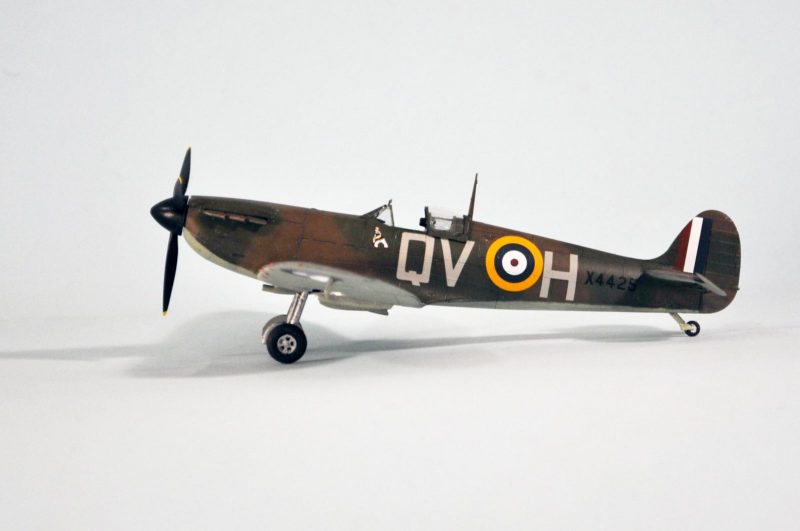
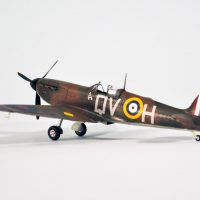
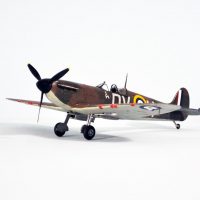
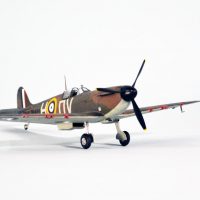
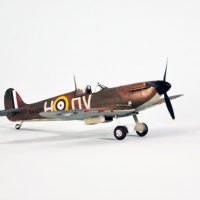
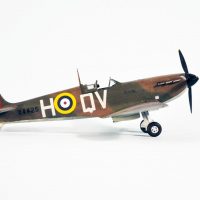

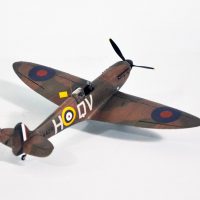
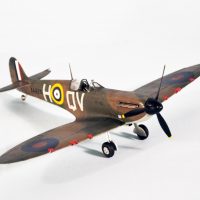
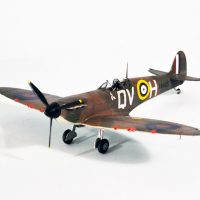
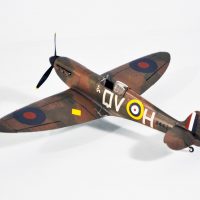
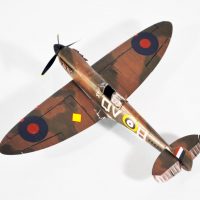
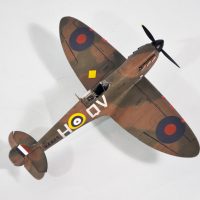
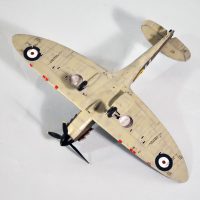
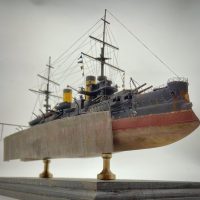

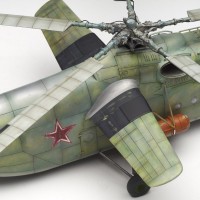
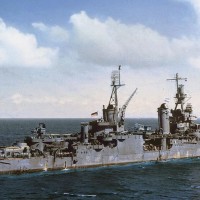
Amazing Spitfire
Excellent build and excellent historical part, Tom!
A very fine looking Spitfire, Tom.
Thanks for sharing this interesting history part.
Always enjoy the history Tom and the model is not bad either
Great looking Spitfire! Eduard really seemed to capture the fuselage detail and in your hands turned out great.
The yellow diamond on the left wing, does that indicate a squadron or section leader, or is that for identification for the ground crews?
It's a patch that turned color if poison gas was present. They were still worried about that through 1940.
When I read your article over at MM the other day, I knew I have to get this and demote the Tamiya version I built. Do you anticipate Eduard re- releasing this Mk 1 as a stand alone Profi-pack boxing?
Sprue Brothers has this limited release kit with both versions still available. $78 (down from $98). Eduard says a Profipack will come out in October, then another dual combo of the Spitfire IIa and IIb in December.
Excellent build and a masterly outcome!
Thanks Roland.
Nice build and article, thank you for sharing!
Great looking Spit.!
Great looking Spit Tom - well done!